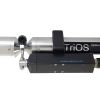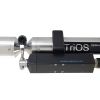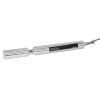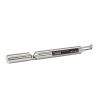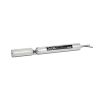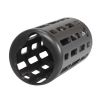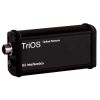TriOS W55 V2 Mechanical Wiper
The TriOS W55 V2 is a mechanical wiper designed for use with the NICO, NICO plus, and OPUS UV sensors.
Features
- Cleans UV optics of sensor, extending maintenance intervals
- Wipe is initiated from supply voltage of 12-24 VDC
- Requires wiper axis & blade set for appropriate path length
- Expedited repair and warranty service
- Lifetime technical support
- More
Overview
The TriOS W55 V2 Mechanical Wiper offers an additional cleaning option for TriOS NICO, NICO plus, and OPUS sensors with path lengths up to 10mm. The wiper housing can be mounted on the sensor in just a few steps and offers reliable cleaning of the measuring window. The new magnetic lock of the axle allows for a quick and easy wiper blade change without any tools.
Blockage Detection
The new version of the wiper now has blockage detection and removal and a service mode that increases the life of the wiper with regular use. The accessory can also be used in seawater up to a depth of 10m.
|
Power Supply
|
12-24 VDC (±10%)
|
|
|
Power Consumption
|
About 2-6 W in operation; max. 0.75 W in standby
|
|
|
|
||
|
Path Lengths
|
2mm, 5mm, 10mm
|
|
|
Maximum Pressure
|
3 bar
|
|
|
Protection Type
|
IP68
|
|
|
Inflow Velocity
|
Up to 10 m/s
|
up to 32.8 fps
|
|
Oparating Temperature
|
+2 to +40°C
|
~ +35.6 °F to +104 °F
|
|
Storage Temperature
|
-10 to +70 °C
|
~ +14 °F to +158 °F
|
|
|
||
|
Control Connection
|
4-pin M8-plug, includes 1.5m pigtail adapter
|
|
|
Trigger Input
|
5-24 VDC ±10%
|
|
|
Current Consumption of Trigger Input
|
2-15 mA
|
|
|
Operating Time (max.)
|
3 seconds
|
|
|
|
||
|
Dimensions L x ø
|
175mm x 80mm
|
~ 6.9“ x 3.2“
|
|
Weight
|
0.52 kg
|
~ 1.15 lbs
|
|
Materials
|
NBR, POM, PE (PP, EPDM), Titanium or V4A
|
|
|
Warranty
|
1 Year (EU & USA: 2 Years)
|
|
|
Support Effort
|
Typically ≤ 0.5 hours/month
|
|
|
Maintenance interval
|
Application dependent | |
In The News
Wildfire Prevention in the Sierra Nevada Region with the Yuba Watershed Institute
Though recent wildfires have sparked new conversations about wildfire management and response, groups like the Yuba Watershed Institute have been monitoring the forests and water resources of the Sierra Nevada region for decades, managing approximately 5,000 acres of land with the Bureau of Land Management (BLM) and about 7,000 acres in private land partnerships. The goal of the Institute is to work with local communities and land agencies to improve watershed and forestry management through informed practices and public outreach. The goals of the Yuba Watershed Institute are three-fold: Improve the ability of fire suppression agencies like the California Department of Forestry and Fire Protection ( CAL FIRE ) and the US Forest Service.
Read MoreWave Sensors Integration with NexSens Buoys: A Cutting-Edge Solution for Wave Measurment
Real-time wave data supports accurate weather prediction, safe and efficient maritime operations, and provides valuable safety and operating condition information for recreation and commercial fishing. Understanding wave dynamics also helps with the design of protective coastal structures like seawalls, breakwaters, and jetties. It also supports better prediction of their impact on sediment transport and coastal geomorphology. Wave data is a key factor in qualifying and designing offshore wind farms and harnessing kinetic energy for electrical generation. It helps with the understanding of ocean-atmosphere interactions and contributes to studies of sea-level rise and climate change impacts.
Read MoreSpring 2025 Environmental Monitor Available Now
In the Spring 2025 edition of the Environmental Monitor, we highlight partnerships across the world and the importance of collaboration between government agencies, universities, environmental groups, local communities, and other stakeholders. From great white shark research in Cape Cod to monitoring fisheries in Lake Erie, this latest edition underscores partnerships that connect stakeholders in a watershed through environmental data. With an emphasis on data sharing, a combination of real-time and discrete sampling keeps the public and partners informed of environmental conditions. Our writers also sought out science professionals dedicated to working with peers within and outside of the environmental sector.
Read More






